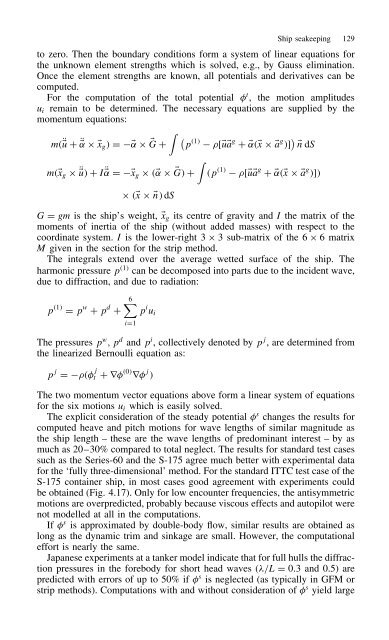Practical Ship Hydrodynamics
Practical Ship Hydrodynamics
Practical Ship Hydrodynamics
Create successful ePaper yourself
Turn your PDF publications into a flip-book with our unique Google optimized e-Paper software.
<strong>Ship</strong> seakeeping 129<br />
to zero. Then the boundary conditions form a system of linear equations for<br />
the unknown element strengths which is solved, e.g., by Gauss elimination.<br />
Once the element strengths are known, all potentials and derivatives can be<br />
computed.<br />
For the computation of the total potential t , the motion amplitudes<br />
ui remain to be determined. The necessary equations are supplied by the<br />
momentum equations:<br />
� �p ⊲1⊳<br />
m⊲R Eu C R E˛ ðExg⊳ D E˛ ð EG C<br />
[EuEa g CE˛⊲Ex ðEa g ⊳] � En dS<br />
m⊲Exg ð R Eu⊳ C IR �<br />
E˛ D Exg ð ⊲E˛ ð EG⊳ C ⊲p ⊲1⊳<br />
[EuEa g CE˛⊲Ex ðEa g ⊳]⊳<br />
ð ⊲Ex ðEn⊳ dS<br />
G D gm is the ship’s weight, Exg its centre of gravity and I the matrix of the<br />
moments of inertia of the ship (without added masses) with respect to the<br />
coordinate system. I is the lower-right 3 ð 3 sub-matrix of the 6 ð 6matrix<br />
M given in the section for the strip method.<br />
The integrals extend over the average wetted surface of the ship. The<br />
harmonic pressure p ⊲1⊳ can be decomposed into parts due to the incident wave,<br />
due to diffraction, and due to radiation:<br />
p ⊲1⊳ D p w C p d C<br />
6�<br />
iD1<br />
p i ui<br />
The pressures p w ,p d and p i , collectively denoted by p j , are determined from<br />
the linearized Bernoulli equation as:<br />
p j D ⊲ j t Cr ⊲0⊳ r j ⊳<br />
The two momentum vector equations above form a linear system of equations<br />
for the six motions ui which is easily solved.<br />
The explicit consideration of the steady potential s changes the results for<br />
computed heave and pitch motions for wave lengths of similar magnitude as<br />
the ship length – these are the wave lengths of predominant interest – by as<br />
much as 20–30% compared to total neglect. The results for standard test cases<br />
such as the Series-60 and the S-175 agree much better with experimental data<br />
for the ‘fully three-dimensional’ method. For the standard ITTC test case of the<br />
S-175 container ship, in most cases good agreement with experiments could<br />
be obtained (Fig. 4.17). Only for low encounter frequencies, the antisymmetric<br />
motions are overpredicted, probably because viscous effects and autopilot were<br />
not modelled at all in the computations.<br />
If s is approximated by double-body flow, similar results are obtained as<br />
long as the dynamic trim and sinkage are small. However, the computational<br />
effort is nearly the same.<br />
Japanese experiments at a tanker model indicate that for full hulls the diffraction<br />
pressures in the forebody for short head waves ( /L D 0.3 and 0.5) are<br />
predicted with errors of up to 50% if s is neglected (as typically in GFM or<br />
strip methods). Computations with and without consideration of s yield large
















